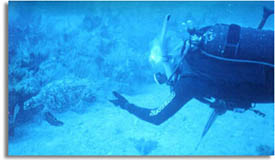|
May 2005
 |
|
Hawks Bill Sea Turtle, Gitmo Bay, Cuba Photo Gabe Wilson © |
The National Oceanic and Atmosphere Administration Fisheries Service Office
for Law Enforcement, the S.C. Department of Natural Resources, the Georgia
Department of Natural Resources and the U.S. Coast Guard are teaming up
again this
year with commercial fishermen to protect threatened and endangered sea
turtles along the coasts of South Carolina and Georgia.
The commercial shrimp-fishing season will likely open in state waters along
the South Carolina and Georgia coasts in early- to mid- June, and fishermen
trawling in those areas are likely to encounter female sea turtles that are
returning to their home nesting sites to lay eggs and juveniles of several
species returning to summer foraging grounds. Federal and state regulations
require fishermen to utilize Turtle Excluder Devices (TEDs) in their nets
so the surface-breathing turtles can escape the nets without being drowned.
U.S. Coast Guard boarding officers from Georgia and South Carolina recently
attended TED training at the Southeast Regional Fisheries Training Center
in Charleston in preparation for law enforcement efforts during the
upcoming shrimp season. The National Marine Fisheries Service Pascagoula
Lab will also be sending TED gear experts to locations in South Carolina
and Georgia to conduct training for law enforcement and to assist in
dockside courtesy inspections.
"This is an ideal situation for the shrimpers, law enforcement and the sea
turtles," said Jason Lind, an instructor at the Southeast Regional
Fisheries Training Center and U.S. Coast Guard boarding officer. "The
ultimate goal of law enforcement is compliance. If we can ensure the
shrimpers' TEDs are in compliance before the season opens, we are all
getting a head start on our job, which is to protect sea turtles along our
coasts."
The TED is a grid of bars with an opening either at the top or the bottom.
The grid is fitted into the neck of a shrimp trawl. Small animals like
shrimp slip through the bars and are caught in the bag end of the trawl.
Large animals such as turtles and sharks, when caught at the mouth of the
trawl, strike the grid bars and are ejected through the opening.
The National Oceanic and Atmospheric Administration Fisheries Service has
been able to show that TEDs are effective at excluding up to 97 percent of
sea turtles with minimal loss of shrimp.
"We believe that the TEDs, now approved, are efficient at reducing sea
turtle mortality," said Sally Murphy, a biologist with the S.C. Department
of Natural Resources. "The means to lower mortality is now compliance and
enforcement."
Data collected aboard research vessels in South Carolina indicates
interaction rates between shrimp boats and sea turtles are relatively high.
"We calculate that hundreds or thousands of interactions take place every
season," said David Whitaker, a South Carolina DNR fishery manager, "so the
relatively few sea turtle strandings we see compared to the interaction
rate suggests that TEDs are working pretty well."
"The serious decline in sea turtle nests over the years has caused alarm
for the future of the species," said Col. Terry West, chief of law
enforcement for Georgia DNR. "By conducting courtesy TED checks, we can
assure that commercial shrimp boats are using a legal device before they
start to fish, thereby helping to decrease the number of strandings we have
each year and increasing the sea turtles' chance for survival."
|